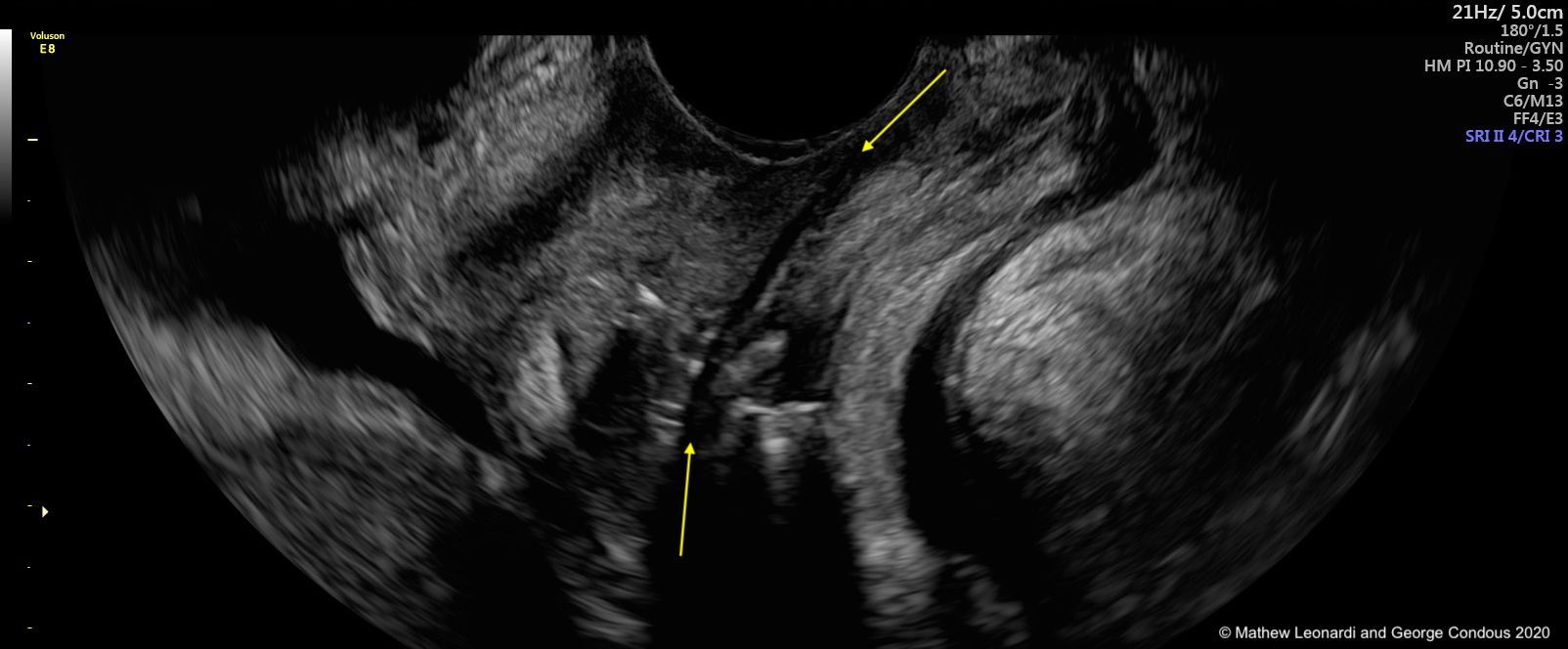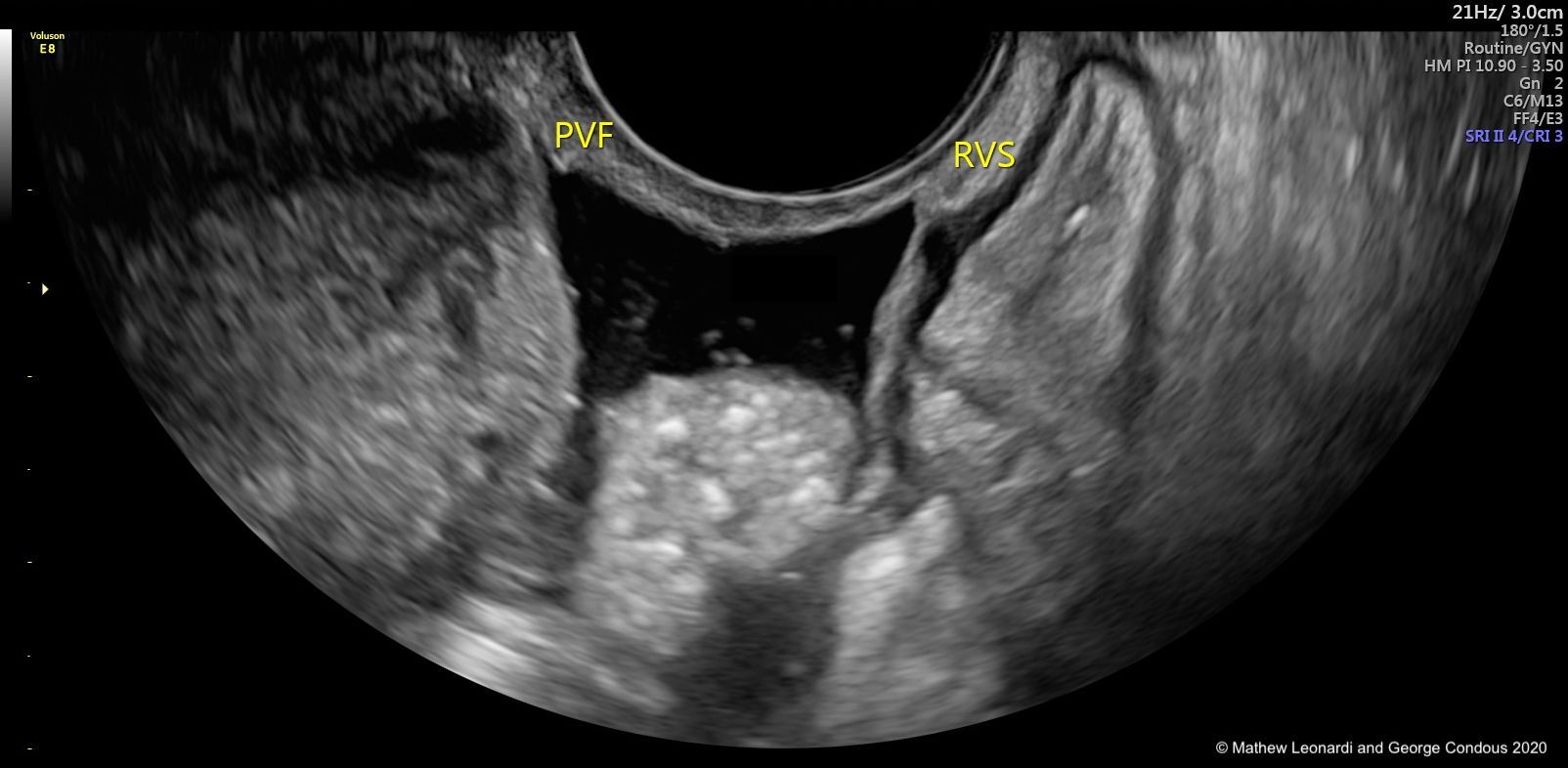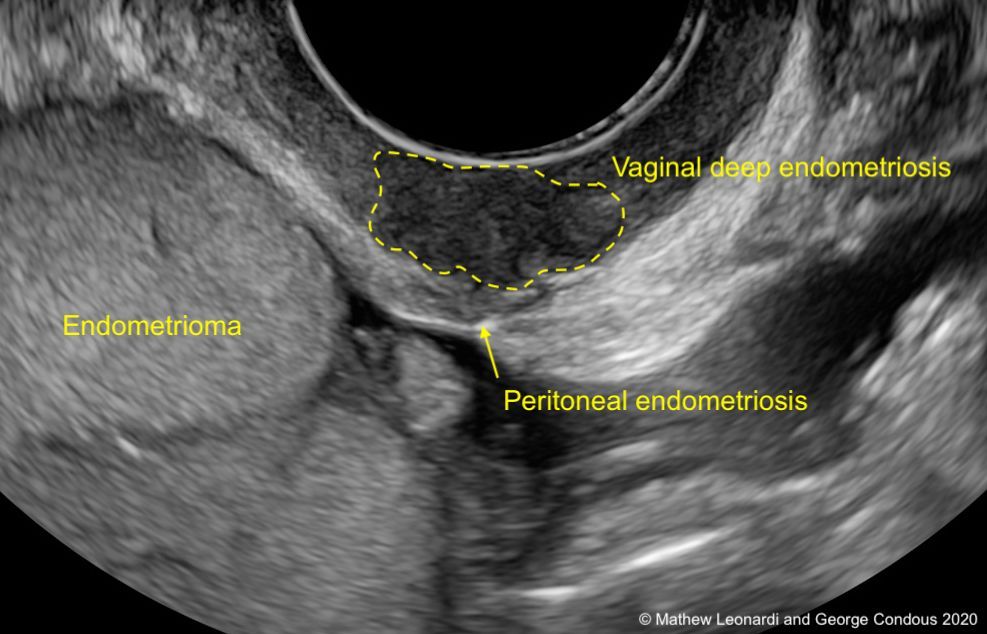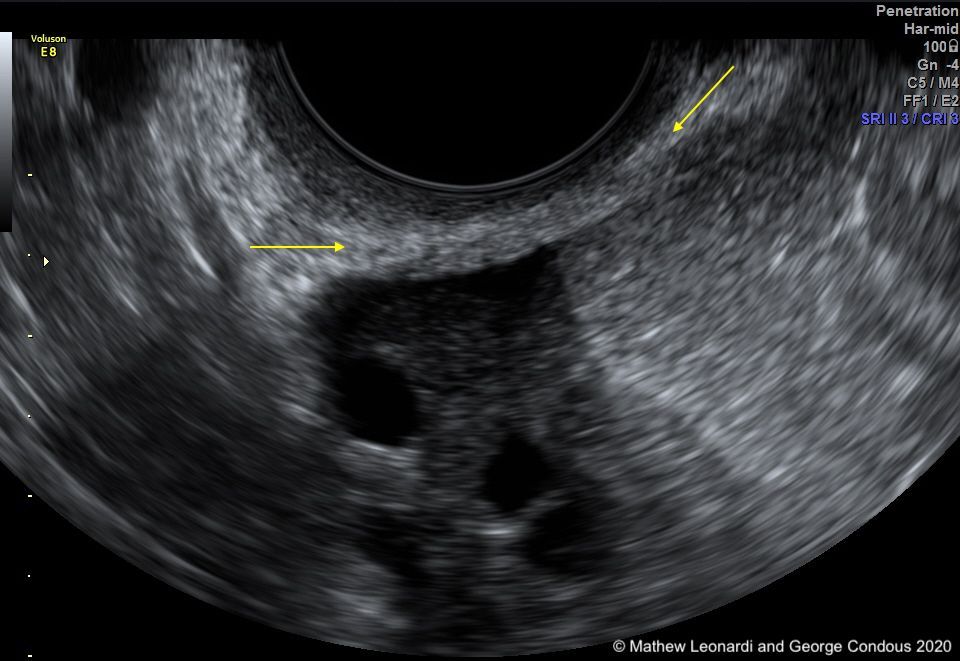Noninvasive ultrasound diagnosis of endometriosis
Can technology help provide answers to a complex condition? This guide demonstrates how to use ultrasound as a first-line diagnostic tool.
Endometriosis is a chronic inflammatory condition estimated to affect up to 10% of or 176 million reproductive-aged women.1,2
The classic collection of signs and symptoms include cyclical pain during menstruation (dysmenorrhea), pain with deep penetrative intercourse (dyspareunia), pain with bowel movements (dyschezia), non-cyclical pelvic pain (chronic pelvic pain (CPP) that lasts more than 6 months), and infertility.
There is no question that endometriosis remains enigmatic with respect to etiology1 and diagnosis.3 In fact, many organizations maintain that diagnostic laparoscopy and histological assessment is the gold standard approach to diagnosis.4,5 Rightfully so, this is being challenged.
In 2020, is surgery necessary to achieve a diagnosis? In one camp, there are experts who advocate for issuing a presumptive diagnosis and offering empiric therapy to women who present with classic symptoms without a surgical or histologic diagnosis,6,7 with the idea of reserving surgery for those refractory to medical therapy.
Another camp advocates for increased use of noninvasive tools to diagnose endometriosis,8-11 regardless of whether medications or surgery are planned.
At this point, neither camp is wrong. Diagnosing all phenotypes of endometriosis noninvasively has not been demonstrated in the literature, but certainly, two of the three phenotypes - ovarian endometrioma (OE) and deep endometriosis (DE) - can be accurately and reliably diagnosed on ultrasound.12
Superficial endometriosis (SE) remains the most elusive phenotype when it comes to noninvasive diagnosis, although we are making progress with it.
We believe that in an ideal world, contemporary ob/gyns can optimize use of technology – specifically ultrasound, our go-to first-line imaging tool in women’s health – to provide answers for patients who may be suffering from endometriosis.
To facilitate that, this article describes use of ultrasound for endometriosis and outlines an approach to noninvasive diagnosis, putting tools in the hands of clinicians to improve their local practices.
Utility of ultrasound for endometriosis
Ultrasound is the first-line imaging modality for reproductive or abdominopelvic complaints in women. The majority of patients who seek medical attention for possible endometriosis-related symptomatology are referred for pelvic ultrasound, which is traditionally done transabdominally and/or transvaginally.
The American Institute of Ultrasound in Medicine (AIUM) recommends pelvic ultrasound that includes assessment of the uterus, ovaries, and rectouterine pouch for “fluid or mass.”13 This is what we classify as basic pelvic ultrasound.
Essentially, basic pelvic ultrasound has the potential to diagnose OE. Although DE commonly exists in the rectouterine pouch, also known as the pouch of Douglas (POD) or cul-de-sac, it is not typically described as “mass”-like and the vast majority of sonographers/radiologists are not trained to identify and document it.
In addition to performing the elements of a basic pelvic ultrasound, we advocate for an advanced evaluation in all patients with endometriosis-related symptomatology that is in line with the recommendations of the International Deep Endometriosis Analysis (IDEA) group.14
We have dubbed this advanced pelvic ultrasound and it includes direct visualization of anatomic structures in the anterior and posterior compartments for DE and assessment of pelvic organ mobility.
Specifically, within the anterior compartment, the bladder and ureters should be evaluated. The posterior compartment consists of the bowel, uterosacral ligaments (USLs), torus uterinus, posterior vaginal fornix (PVF), rectovaginal septum (RVS), and rectouterine pouch. Assessment of pelvic organ mobility is necessary and highly clinically useful due to the strong likelihood of adhesion development in those with endometriosis.
Most important is evaluation of the state of the rectouterine pouch, the area between the cervix/posterior vagina and bowel in the anterior/posterior plane and between the USLs in the lateral plane. This potential space may become “obliterated” (i.e. no longer a potential space), which can be appreciated by using the sliding sign technique.15
Ovarian mobility is also relevant and can be assessed along the pelvic sidewall laterally, USL inferiorly, or uterus medially.16 Often, the ovarian is adherent to an area of endometriosis and involves an OE.
The literature supports use of ultrasound for endometriosis.12,17,18 Several ob/gyn governing bodies that produce clinical guidelines are also beginning to acknowledge the use of the technology for endometriosis.5,19 A Cochrane systematic review and meta-analysis on diagnostic accuracy studies completed in 2016 demonstrated that for OE, transvaginal ultrasound (TVS) has sensitivity of 93% and specificity of 96%.
For DE, TVS has a sensitivity of 79% and specificity of 94%. Reid et al. demonstrated that the sliding sign predicts obliteration of the rectouterine pouch with accuracy of 93%, sensitivity of 83%, and specificity of 97%.15
In 2016, the IDEA group published a consensus opinion with the aim of increasing awareness, improving education on endometriosis ultrasound mapping, and decreasing heterogeneity between published reports on diagnostic accuracy.14 Although the meta-analysis demonstrates a good diagnostic accuracy for ultrasound, it is likely limited due to multiple units using varying scanning methods and sometimes conflicting nomenclature.
A classic example is use of the term rectovaginal endometriosis, which is not a true anatomic structure but a general area. The IDEA consensus opinion publication and growing expertise in endometriosis ultrasound both broadly and locally should actually yield even greater diagnostic accuracy now than in the past.
How to diagnose endometriosis non-invasively using ultrasound
There is no one right way to perform ultrasound to diagnose endometriosis,14,18,20,21 as long as the imaging is done thoroughly and systematically. We have published a step-by-step method that is Free Access to all in the Australasian Journal of Ultrasound in Medicine.20
Here, we describe the appearance of the three different endometriosis phenotypes–OEs, DE, and SE–and the best-known methods for detecting them. We routinely perform TVS, but may consider transrectal ultrasound in patients who cannot tolerate a TVS. All descriptions, figures, and videos below are relevant to TVS. OEs are the most common. As such, we will first describe scanning in the adnexa, then discuss the anterior and posterior compartments for DE, and finally, touch upon advances in ultrasound for SE.
Adnexa–ovaries
All ovarian masses should be described in accordance with the International Ovarian Tumor Analysis (IOTA) consensus.22 An OE is an ovarian cyst containing thick, old blood, which at surgery appears brown, hence the colloquial name “chocolate cyst.” OEs may vary in size, but they generally have a typical appearance on ultrasound: unilocular, the contents of the cystic lesion have homogenous low-level or “ground glass” echogenicity, and there is minimal blood flow in the cyst wall on color or power Doppler (See Figures 1 through 4). For an elaborate discussion of atypical OEs, please refer to Van Holsbeke et al.23
Ovarian mobility must be assessed, regardless of the presence of an OE. Ovarian immobility is more often seen in the context of OEs.16 Mobility should be assessed laterally against the pelvic sidewall and inferomedially against the uterus/USL (For visual reference, please see Video 1, Video 2, and Video 3).
This is done by applying pressure to the ovary with the ultrasound probe and/or the operator’s non-scanning hand. The ovaries may also be adherent to each other, called “kissing ovaries,” and that is often seen in the setting of bilateral OEs (See Video 4). An OE should raise a red flag for DE elsewhere in the pelvis,24,25 often in the posterior compartment.
Adnexa–Fallopian tubes
Anatomical distortion is common in patients with endometriosis and occasionally results in tubal blockage. The inability of fluid to transit through the tubes may result in the development of a hydrosalpinx or hematosalpinx. On ultrasound, these often appear as elongated and serpentine unilocular cystic (either anechoic or low-level echogenic) lesions with “incomplete septations” (Figure 5).
Figure 5

When these abnormalities are identified, endometriosis should be entertained. In the presence of endometriosis, abnormal Fallopian tubes contribute to both the American Society of Reproductive Medicine (ASRM) revised endometriosis classification score, which determines staging,26 and the Endometriosis Fertility Index (EFI).27 Therefore, any ultrasound-based information obtainable on the Fallopian tubes is clinically useful for both patient and healthcare provider.
Deep endometriosis
The posterior compartment is the most common site of DE.28 The ultrasound operator may use the opportunity of the probe entering the vagina to visualize the retroperitoneal aspect of the rectum and RVS to the level of the rectouterine pouch (See Figure 6).
Figure 6

When there is fluid in the rectouterine pouch, the boundary of the retro- and intraperitoneal rectum and the most superior aspect of the RVS are easier to visualize (See Figure 7).
Figure 7

At the maximum insertion depth, when the probe is positioned posterior to the cervix, the PVF can be appreciated as the hypoechoic layer in direct contact with the probe. A sweep from one side to the other should be done to observe the entire posterior vagina (See Video 5).
DE of the retroperitoneal rectum or RVS is rare, but when present, you should note whether the lesion lies within one specific anatomic area or extends between areas (e.g. lesions may extend from the vagina to the rectum through the RVS). DE of the PVF is characterized by significant and focal thickening of the vagina and sometimes can be distinguished from the surrounding normal vagina by its slight hypoechoic nature (See Figure 8).
Figure 8

Clinicians should always directly visualize the vagina on speculum examination. Ultrasound operators should assess the proximity of another normal or abnormal anatomical structure to the PVF DE. The rectum is very close and may be tethered, even when not directly affected by DE itself (See Video 6). If surgical excision is planned, it may be prudent to measure the distance between the PVF DE and the closest aspect of the rectum.
DE of the bowel generally occurs in the muscularis externa layer and does not infiltrate through to the mucosa (Figures 9 through 12, Video 7).
A normal bowel wall is depicted in Video 8. The anterior rectum, which begins after the bowel transitions from retroperitoneal to intraperitoneal, is the most common site of DE in the bowel.
It is possible, although more challenging, to visualize rectosigmoid junction or sigmoid colon DE because of the physical distance between the probe and the disease. The goal is to follow the bowel wall as long as possible. When DE is noted, the IDEA consensus suggests six unique characteristics,14 which should be routinely considered.
The distance from the lowest nodule to the anal verge should be measured to assist in surgical planning as the type and location of bowel surgery has implications on surgical risk.29
The USLs are one of the most common sites for DE.28 Recently, it has become apparent that the normal USLs are quite easy to visualize on TVS (See Figure 13).
Figure 13

We have published an approach to visualization, which is Free Access,30 and a proposed nomenclature system for DE that involves the USLs.31 One essential step is understanding the normal appearance and thickness of the rectouterine pouch peritoneum (See Video 9).
DE involving the USLs may infiltrate the parametrium, the PVF, or the torus uterinus, which is defined as the transverse thickening that binds the USLs along the posterior cervix. In most cases, USL DE is confined to the USLs (Figures 14 and 15), but there are often associated adhesions, resulting in ovarian fixation or rectouterine pouch obliteration (See Video 3, Video 10, and Video 11).
Bladder DE is rare (See Figure 16), but the bladder should always be assessed because it is so simple to do. Place the ultrasound probe in the anterior vaginal fornix and swing side-to-side, visualizing the muscularis layer for focal thickening and hypoechoic changes.
Similarly, intrinsic ureteral endometriosis is rare. DE of the USLs infiltrating the parametrium may extrinsically compress the ureter leading to hydroureter and hydronephrosis (See Video 12). Even when not extrinsically compressed, the ureters may be kinked due to adjacent DE, and so, the ureters should be evaluated in all patients and it is easy to learn how to do so.32,33
It may be appropriate to evaluate the kidneys for hydronephrosis in all patients in whom endometriosis is a concern, although we restrict this particular add-on ultrasound to those with demonstrable hydroureter and/or large USL/parametrial DE nodules.
Rectouterine pouch obliteration
The rectouterine pouch is a potential space at the most inferior aspect of the pelvis. Technically, a normal rectouterine pouch is present when the peritoneum between the USLs (laterally) and the cervix and rectum (anterior-posterior) is visible at time of surgery.
This potential space can become obliterated in the context of severe adhesions due to endometriosis. There is a strong link between rectouterine pouch obliteration and bowel endometriosis.15,34
Presence of an obliterated rectouterine pouch has major surgical implications.3 As such, it must be evaluated for on ultrasound using the sliding sign technique described by Reid et al.15 and reinforced by the IDEA consensus.14 Ultrasound operators will sometimes need to use both hands to perform this dynamic, real-time technique; in the case of an anteverted uterus, we recommend holding the ultrasound probe still in the anterior vaginal fornix with one hand and with the other, applying pressure to the patient’s lower abdomen to move the uterus up and down.
Occasionally, this will not elicit the sliding sign sufficiently and applying pressure to the uterus (either with the probe in the anterior vaginal fornix or with the probe up against the external cervical os) will be necessary. The test is considered positive when the uterus and cervix move independently (i.e. slide) along the PVF, anterior rectum and sigmoid (See Video 13).
Conversely, if the uterus and cervix move in unison with the structures posteriorly, the test is negative and the pouch is thought to be obliterated (See Video 14).
In a retroverted uterus, only the hand holding the probe needs to move. The probe should be in the PVF and with pressure, the operator should be able to push the uterine fundus cephalad, allowing it to slide against the PVF and rectum (See Video 15).
A small, often fluid-filled, space should become apparent between the cervix/mid-uterine body and PVF. In an obliterated rectouterine pouch, the fundus will not move independently from the PVF and/or the rectum (See Video 16).
There is unlikely to be any fluid collection in the case of obliteration, though partial states of obliteration (e.g. the right side of the uterus does not slide against the structures posteriorly, but the left does) may exist. In the case of partial obliteration, the degree and location of obliteration should be described.
Superficial endometriosis
Thus far, SE has been an elusive target for noninvasive diagnosis. Studies that have attempted to demonstrate SE have done so with poor results.35-37 Recently, by developing the novel ultrasound technique called saline-infusion sonoPODography (SPG), we are one step closer to visualizing SE.38
Essentially, this procedure involves introduction of normal saline into the rectouterine pouch through the uterus and Fallopian tubes (when patent) via an intrauterine catheter, at which point, the contours of the peritoneal surfaces in the lower pelvis are inspected.
In brief, we define the appearance of SE (all relative to a peritoneal surface) on TVS as follows: 1) hyperechoic projections ( See Figure 17), 2) hypoechoic areas (See Figures 17 and 18), 3) cystic areas (See Figure 19), 4) filmy adhesions (See Video 17) and 5) peritoneal pockets as demonstrated by incomplete septations and “entrapped” fluid (See Video 17).
We are currently performing a prospective study to investigate the diagnostic accuracy of this technique more thoroughly.
Limitations
While ultrasound has clear benefits, its limitations should be acknowledged. Most importantly, ultrasound is operator-dependent. The operator must know how to perform the techniques described and appropriately capture images and video clips. Today, no governing body yet requires that sonographers assess for direct visualization of DE or dynamic signs of pelvic adhesions.
Similarly, radiologists and sonologists are not yet consistently educated on how to interpret and report on advanced pelvic ultrasound for endometriosis. Broadly, this limits its accessibility outside specialized tertiary care centers. For both the operators and interpreters of ultrasonography, the didactic and practical curriculum needs updating.
In addition, TVS has a maximum penetration depth, limiting the ability to diagnose lesions above the pelvic brim. Anatomical areas including the small bowel, cecum, appendix, and diaphragm are not yet assessable for DE on TVS. Magnetic resonance imaging may play a role in evaluating these areas but is beyond the scope of this paper.
Finally, the diagnostic performance of TVS is not perfect. Historically, TVS has been less accurate for anatomic areas such as the USLs and parametrium, when there may be ureteral involvement.
It is hoped that the IDEA consensus opinion will improve diagnostic performance by standardizing the approach to TVS and unifying nomenclature. Research that is ongoing on how to refine techniques and advance ultrasound technology should continue to improve the ability of TVS to capture all phenotypes of endometriosis.
Conclusion
This instructional guide has outlined all aspects of ultrasound evaluation in patients with suspected endometriosis. Our approach is guided by the IDEA group consensus statement14 and our personal experience. We understand that ultrasound is not the only method for evaluating endometriosis and under the umbrella of ultrasound evaluation, there may be different techniques and procedures.
Regardless of the approach, we recommend a systematic one that is performed and interpreted by experts. Patients with endometriosis have experienced use of inadequate diagnostic tools for far too long (and still do). It is important that if we are making conclusions based on imaging tools, those tools are used properly with a clear understanding of benefits and limitations. In our unit, a negative ultrasound does not rule out SE (though it does rule out DE, OEs, and rectouterine pouch obliteration).
This means there may still be a role for laparoscopy to diagnose patients with SE, but we only use it when patients prefer surgery or their condition requires it.
Overall, we are getting closer and closer to being able to offer patients a way to visualize their disease noninvasively and to rule out the disease. Ongoing research, we hope, will continue to improve what is already a highly useful clinical tool.
__
References
- Giudice LC. Endometriosis. N Engl J Med. 2010;362:2389-2398.
- Adamson GD, Kennedy S, Hummelshoj L. Creating solutions in endometriosis: Global collaboration through the World Endometriosis Research Foundation. J Endometr. 2010;2:3-6.
- Leonardi M, Singh SS, Murji A, et al. Deep endometriosis: a diagnostic dilemma with significant surgical consequences. J Obstet Gynaecol Canada. 2018;40:1198-1203.
- Leyland N, Casper R, Laberge P, et al. Endometriosis: diagnosis and management. J Obstet Gynaecol Canada. 2010;32:S1-S28.
- American College of Obstetricians and Gynecologists. Practice Bulletin No. 114: Management of Endometriosis. Obstet Gynecol. 2010;116:223-236.
- Agarwal SK, Chapron C, Giudice LC, et al. Clinical diagnosis of endometriosis: a call to action. Am J Obstet Gynecol. 2019;220:354.e1-354.e12.
- Kho KA, Shields JK. Diagnosis and management of primary dysmenorrhea. JAMA. 2019;344:1-2
- Benacerraf BR, Groszmann Y. Sonography should be the first imaging examination done to evaluate patients with suspected endometriosis. J Ultrasound Med. 2012;31:651-653.
- Somigliana E, Vercellini P, Vigano’ P, Benaglia L, Crosignani PG, Fedele L. Non-invasive diagnosis of endometriosis: The goal or own goal? Hum Reprod. 2010;25:1863-1868.
- Singh SS, Suen MWH. Surgery for endometriosis: beyond medical therapies. Fertil Steril. 2017;107:549-554.
- Menakaya UA, Rombauts L, Johnson NP. Diagnostic laparoscopy in pre-surgical planning for higher stage endometriosis: Is it still relevant? Aust New Zeal J Obstet Gynaecol. 2016;56:518-522.
- Nisenblat V, Bossuyt PMM, Farquhar C, Johnson N, Hull ML. Imaging modalities for the non-invasive diagnosis of endometriosis. Cochrane Database Syst Rev. 2016:Art. No.: CD009591. DOI: 10.1002/14651858.CD009591.
- AIUM Practice Guideline for the Performance of Ultrasound of the Female Pelvis. J Ultrasound Med. 2014;33:1122-1130.
- Guerriero S, Condous G, van den Bosch T, et al. Systematic approach to sonographic evaluation of the pelvis in women with suspected endometriosis, including terms, definitions and measurements: a consensus opinion from the International Deep Endometriosis Analysis (IDEA) group. Ultrasound Obstet Gynecol. 2016;48:318-332.
- Reid S, Lu C, Casikar I, et al. Prediction of pouch of Douglas obliteration in women with suspected endometriosis using a new real-time dynamic transvaginal ultrasound technique: the sliding sign. Ultrasound Obstet Gynecol. 2013;41:685-691.
- Gerges B, Lu C, Reid S, Chou D, Chang T, Condous G. Sonographic evaluation of immobility of normal and endometriotic ovary in detection of deep endometriosis. Ultrasound Obstet Gynecol. 2017;49:793-798
- Tompsett J, Leonardi M, Gerges B, et al. Ultrasound-based endometriosis staging system: validation study to predict complexity of laparoscopic surgery. J Minim Invasive Gynecol. 2019;26:477-483.
- Collins BG, Ankola A, Gola S, McGillen KL. Transvaginal US of endometriosis: looking beyond the endometrioma with a dedicated protocol. RadioGraphics. 2019;39:1549-1568.
- National Institute for Health and Care Excellent. Endometriosis: Diagnosis and Management.; 2017. nice.org.uk/guidance/ng73.
- Leonardi M, Condous G. How to perform an ultrasound to diagnose endometriosis. Australas J Ultrasound Med. 2018;21:61-69.
- Young SW, Groszmann Y, Dahiya N, et al. Sonographer-acquired ultrasound protocol for deep endometriosis. Abdom Radiol. 2019.
- Timmerman D, Valentin L, Bourne TH, Collins WP, Verrelst H, Vergote I. Terms, definitions and measurements to describe the sonographic features of adnexal tumors: a consensus opinion from the International Ovarian Tumor Analysis (IOTA) group. Ultrasound Obstet Gynecol. 2000;16:500-505.
- Van Holsbeke C, Van Calster B, Guerriero S, et al. Endometriomas: Their ultrasound characteristics. Ultrasound Obstet Gynecol. 2010;35:730-740.
- Redwine DB. Ovarian endometriosis: A marker for more extensive pelvic and intestinal disease. Fertil Steril. 1999;72:310-315.
- Exacoustos C, De Felice G, Pizzo A, et al. Isolated ovarian endometrioma: a history between myth and reality. J Minim Invasive Gynecol. 2018;25:884-891.
- American Society for Reproductive Medicine. Revised American Society for Reproductive Medicine classification of endometriosis: 1996 American Society for Reproductive Medicine. Fertil Steril. 1997;67:817-821.
- Adamson GD, Pasta DJ. Endometriosis fertility index: the new, validated endometriosis staging system. Fertil Steril. 2010;94:1609-1615.
- Chapron C, Fauconnier A, Vieira M, et al. Anatomical distribution of deeply infiltrating endometriosis: Surgical improblications and proposition for a classification. Hum Reprod. 2003;18:157-161.
- Khan MAS, Ang CW, Hakeem AR, Scott N, Saunders RN, Botterill I. The impact of tumour distance from the anal verge on clinical management and outcomes in patients having a curative resection for rectal cancer. J Gastrointest Surg. 2017;21:2056-2065.
- Leonardi M, Condous G. A pictorial guide to the ultrasound identification and assessment of uterosacral ligaments in women with potential endometriosis. Australas J Ultrasound Med. 2019;22:157-164.
- Leonardi M, Martins WP, Espada M, Arianayagam M, Condous G. A proposed technique to visualize and classify uterosacral ligament deep endometriosis with and without infiltration into the parametrium or torus uterinus. Ultrasound Obstet Gynecol. April 2019:uog.20300.
- Bean E, Naftalin J, Jurkovic D. How to assess the ureters during pelvic ultrasound. Ultrasound Obstet Gynecol. 2018.
- Aas-Eng K, Salama M, Sevelda U, Ruesch C, Nemeth Z, Hudelist G. Learning curve for detection of the distal part of ureters by transvaginal sonography (TVS): a feasibility study. Ultrasound Obstet Gynecol. June 2019.
- Khong SY, Bignardi T, Luscombe G, Lam A. Is pouch of Douglas obliteration a marker of bowel endometriosis? J Minim Invasive Gynecol. 2011;18:333-337.
- Robinson AJ, Rombauts L, Ades A, Leong K, Paul E, Piessens S. Poor sensitivity of transvaginal ultrasound markers in diagnosis of superficial endometriosis of the uterosacral ligaments. J Endometr Pelvic Pain Disord. 2018;10:10-17.
- Reid S, Leonardi M, Lu C, Condous G. The association between ultrasound-based ‘soft markers’ and endometriosis type/location: A prospective observational study. Eur J Obstet Gynecol Reprod Biol. 2019;234:171-178.
- Chowdary P, Stone K, Ma T, et al. Multicentre retrospective study to assess diagnostic accuracy of ultrasound for superficial endometriosis-Are we any closer? Aust New Zeal J Obstet Gynaecol. 2019;59:279-284.
- Leonardi M, Espada M, Lu C, Stamatopoulos N, Condous G. A novel ultrasound technique called saline infusion sonoPODography to visualize and understand the pouch of Douglas and posterior compartment contents: A Feasibility Study. J Ultrasound Med. 2019;38:3301-3309.
